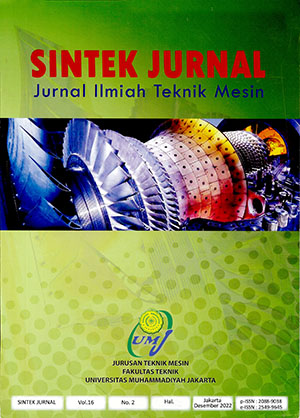Perancangan dan analisis struktur statis terhadap fuselage versi maritim dari prototipe uav v5 produksi
Main Article Content
Abstract
PT. Famindo Inovasi Teknologi (PT. FIT) is a company that works in the drone industry, and currently PT. FIT receives a request from Badan Keamanan Laut Republik Indonesia (BAKAMLA) to design a drone that can float on water. Therefore, my purpose is to design a fuselage of the maritime version from UAV V5 prototype produced by PT. FIT that have a lower fuselage volume of 30 liters and able to withstand a 5G loading. The lower fuselage is designed at 30 liters because the mass of the finished drone is 25 kg. The design will include the shape of the fuselage, rib structure and support structure. After the design is complete, the next step is simulation using Solidworks with static simulation features. The fuselage simulation is done with a mesh size of 8 mm according to the mesh independence test method and 5G loading. The result of the fuselage simulation shows a maximum stress of 17.142 MPa and a maximum displacement of 0.614 mm, so the fuselage of the maritime version from UAV V5 prototype produced by PT. FIT design can be declared as safe.
Article Details
How to Cite
[1]
G. Sutantyo, S. Tobing, and B. Atmoko, “Perancangan dan analisis struktur statis terhadap fuselage versi maritim dari prototipe uav v5 produksi”, sintek. jurnal. ilm. teknik. mesin, vol. 16, no. 2, pp. 68–76, Dec. 2022.
Section
Articles
- Articles published in SINTEK JURNAL are licensed under a Creative Commons Attribution-ShareAlike 4.0 International license. You are free to copy, transform, or redistribute articles for any lawful purpose in any medium, provided you give appropriate credit to the original author(s) and SINTEK JURNAL, link to the license, indicate if changes were made, and redistribute any derivative work under the same license.
- Copyright on articles is retained by the respective author(s), without restrictions. A non-exclusive license is granted to SINTEK JURNAL to publish the article and identify itself as its original publisher, along with the commercial right to include the article in a hardcopy issue for sale to libraries and individuals.
- By publishing in SINTEK JURNAL, authors grant any third party the right to use their article to the extent provided by the Creative Commons Attribution-ShareAlike 4.0 International license.
References
M. Sadraey, Unmanned Aircraft Design: A Review of Fundamentals. California: Morgan & Claypool, 2017.
J. Sup Um, Drones as Cyber-Physical Systems. Singapore: Springer, 2019.
Federal Aviation Administration, Pilot’s Handbook of Aeronautical Knowledge. New York: Skyhorse Publishing, 2009.
S. HM, Perhitungan Portal Bertingkat dengan cara TAKABEYA, 3rd ed. Jakarta: Soetomo HM, 1981.
S. A. Prabowo, Easy to Use Solidworks 2009. Yogyakarta: C.V ANDI OFFSET, 2009.
Delta Composites, L.L.C., “Design Manual Fiberglass Grating And Structural Products,” U. S., pp. 20–21.


